View in other NatureServe Network Field Guides
NatureServe
Montana
Utah
Wyoming
Idaho
Wisconsin
British Columbia
South Carolina
Yukon
California
New York
Two-striped Mermiria Grasshopper - Mermiria bivittata
Other Names:
Mermiria Grasshopper
General Description
The following comes from Hebard (1928), Brooks (1958), Helfer (1971), Otte (1981), Capinera and Sechrist (1982), Vickery and Kevan (1985), McDaniel (1987), Pfadt (2002), Capinera et al. (2004), and Scott (2010). A large, long-winged grasshopper with sword-shaped (ensiform) antennae. Its face is strongly slanted. Generally, the body color is pale brown or yellowish gray. A dark brown to blackish stripe extends from the back of the eye, across the lateral lobe of the pronotum and onto the forewings (tegmina). The long hind tibia is reddish.
Phenology
Overwinters in the egg stage. Nymphs appear in mid-June, adults are found from mid-July into September and sometimes to early October, depending upon weather conditions (Brust et al. 2008, Capinera and Sechrist 1982, Capineral et al. 2004, Otte 1984, Pfadt 2002, Scott 2010, and Vickery and Kevan 1985).
Diagnostic Characteristics
The body length to the end of the forewings is 28 mm to 38 mm for males, and 39 mm to 51 mm for females. There is a white or ivory stripe below the black stripe on the forewings. Spines on the hind tibia are tipped with black (Hebard 1928, Brooks 1958, Helfer 1971, Otte 1981, Capinera and Sechrist 1982, Vickery and Kevan 1985, McDaniel 1987, Pfadt 2002, Capinera et al. 2004, and Scott 2010).
Could be confused with the
Short-winged Toothpick Grasshopper (
Pseudopomala brachyptera), which is smaller with short wings. In the west, there are 2 other species of
Mermiria,
M. picta (in the Dakotas and Wyoming) and
M. texana (from Colorado southward to Arizona, New Mexico, and Texas (Capinera and Sechrist 1982, Capinera et al. 2004, Otte 1984, Pfadt 2002, and Scott 2010).
Species Range
Montana Range
Range Descriptions
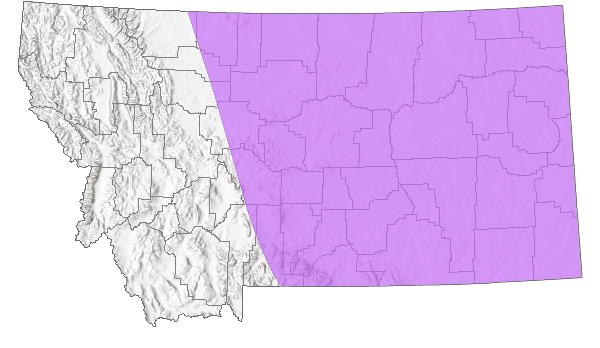
 Native
Native
Range Comments
The Two-striped Mermiria Grasshopper is widely distributed across the U.S. from southern California, eastward to the Carolinas and Georgia, and from the border of Alberta and Saskatchewan southward into Mexico. Its center of distribution is the Great Plains and tallgrass prairies. In Montana, it has been found in 15 counties in the eastern two-thirds of the state (Capinera and Sechrist 1982, Capinera et al. 2004, Otte 1984, Pfadt 2002, Scott 2010, Vickery and Kevan 1985).
Observations in Montana Natural Heritage Program Database
Number of Observations: 13
(Click on the following maps and charts to see full sized version)
Map Help and Descriptions
Relative Density
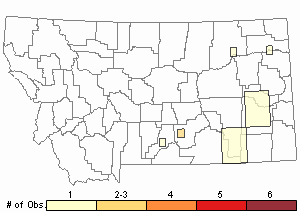
Recency
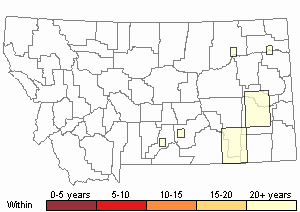

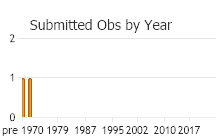
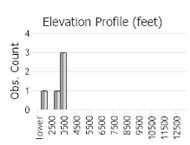 (Observations spanning multiple months or years are excluded from time charts)
(Observations spanning multiple months or years are excluded from time charts)
Habitat
Favors grasslands with stands of tall, lush grasses. In Montana, this species is commonly found in mixedgrass, shortgrass and bunchgrass prairies where small stands of tall grasses occur (Capinera and Sechrist 1982, Capinera et al. 2004, Otte 1984, Pfadt 2002, Vickery and Kevan 1985).
Food Habits
The Two-striped Mermiria Grasshopper is an exclusive grass feeder of at least 18 different species, preferring
Needle-and-Thread (
Stipa comata),
wheat (
Triticum aestivum),
rye (
Secale cereale), oats,
quackgrass (
Elymus repens),
Johnson Grass (
Sorghum halepense),
prairie sandreed (
Calamovilfa longifolia), bluestem,
western wheatgrass (
Elymus smithii), brome,
sand dropseed (
Sporobolus cryptandrus), and gramma grasses (Capinera and Sechrist 1982, Pfadt 2002).
Reproductive Characteristics
The following comes from Capinera and Sechrist (1982), and Pfadt (2002). Courting males upon approaching females stridulate (“sings”) with a burst of two to five strokes of his femora. There is no information relative to mounting and copulation nor how soon females mate and lay eggs. Females oviposit in bare soil, laying the eggs at depths of one and a quarter to one and three-quarters below the surface. The egg mass consists of 14 to 18 eggs held together by a froth rather than a pod, but is protected by a froth plug at the top. The hatching nymphs pass through 5 instars before reaching the adult stage.
Stewardship Responsibility
References
- Literature Cited AboveLegend:
 View Online Publication
View Online Publication Brooks, A.R. 1958. Acridoidea of Southern Alberta, Saskatchewan, and Manitoba (Orthoptera). The Canadian Entomologist (Supplement 9) 90:5-92.
Brooks, A.R. 1958. Acridoidea of Southern Alberta, Saskatchewan, and Manitoba (Orthoptera). The Canadian Entomologist (Supplement 9) 90:5-92. Brust, M.L, W.W. Hoback, and R.J. Wright. 2008. The Grasshoppers of Nebraska. Lincoln, NB: University of Nebraska Extension Service, APHIS.
Brust, M.L, W.W. Hoback, and R.J. Wright. 2008. The Grasshoppers of Nebraska. Lincoln, NB: University of Nebraska Extension Service, APHIS. Capinera, J.L. and T.S. Sechrist. 1982. Grasshoppers of Colorado: Identification, Biology, and Management. Fort Collins, CO: Colorado State University Experiment Station, Bulletin 584S. 161 p.
Capinera, J.L. and T.S. Sechrist. 1982. Grasshoppers of Colorado: Identification, Biology, and Management. Fort Collins, CO: Colorado State University Experiment Station, Bulletin 584S. 161 p. Capinera, J.L., R.D. Scott, and T.J. Walker. 2004. Field Guide to Grasshoppers, Katydids, and Crickets of the United States. Ithaca, NY. Cornell University Press.
Capinera, J.L., R.D. Scott, and T.J. Walker. 2004. Field Guide to Grasshoppers, Katydids, and Crickets of the United States. Ithaca, NY. Cornell University Press. Hebard, M. 1928. The Orthoptera of Montana. Proceedings of the Academy of Natural Sciences of Philadelphia, Vol. 80:211-306.
Hebard, M. 1928. The Orthoptera of Montana. Proceedings of the Academy of Natural Sciences of Philadelphia, Vol. 80:211-306. Helfer, J.R. 1971. How to Know the Grasshoppers, Crickets, Cockroaches, and Their Allies. Revised edition (out of print), Mineola, NY: Dover Publications.
Helfer, J.R. 1971. How to Know the Grasshoppers, Crickets, Cockroaches, and Their Allies. Revised edition (out of print), Mineola, NY: Dover Publications. McDaniel, B. 1987. Grasshoppers of South Dakota. Brookings, SD: South Dakota Agricultural Experiment Station, Bulletin TB 89.
McDaniel, B. 1987. Grasshoppers of South Dakota. Brookings, SD: South Dakota Agricultural Experiment Station, Bulletin TB 89. Otte, Daniel. 1981. The North American Grasshoppers. Volume 1. Acrididae (Gomphocerinae and Acridinae). Harvard University Press. 275 pp.
Otte, Daniel. 1981. The North American Grasshoppers. Volume 1. Acrididae (Gomphocerinae and Acridinae). Harvard University Press. 275 pp. Pfadt, R.E. 2002. Field Guide to Common Western Grasshoppers, 3rd edition. Laramie, WY: Wyoming Agricultural Experiment Station, Bulletin 912, modified by S. Schell and S. Schell for electronic publication. Accessed 19 February 2020. http://www.uwyo.edu/entomology/grasshoppers/field-guide/index.html#fieldguidetoc
Pfadt, R.E. 2002. Field Guide to Common Western Grasshoppers, 3rd edition. Laramie, WY: Wyoming Agricultural Experiment Station, Bulletin 912, modified by S. Schell and S. Schell for electronic publication. Accessed 19 February 2020. http://www.uwyo.edu/entomology/grasshoppers/field-guide/index.html#fieldguidetoc Scott, R.D. 2010. Montana Grasshoppers, Katydids, and Crickets A Pictorial Field Guide to the Orthoptera. MagpieMTGraphics, Billings, MT.
Scott, R.D. 2010. Montana Grasshoppers, Katydids, and Crickets A Pictorial Field Guide to the Orthoptera. MagpieMTGraphics, Billings, MT. Vickery, V. R. and D. K. M. Kevan. 1985. The grasshopper, crickets, and related insects of Canada and adjacent regions. Biosystematics Research Institute, Ottawa, Ontario. Publication Number 1777. 918 pp.
Vickery, V. R. and D. K. M. Kevan. 1985. The grasshopper, crickets, and related insects of Canada and adjacent regions. Biosystematics Research Institute, Ottawa, Ontario. Publication Number 1777. 918 pp.
- Additional ReferencesLegend:
 View Online Publication
View Online Publication
Do you know of a citation we're missing? Anderson, N.L. 1951. Field studies on the biology of range grasshoppers of southeastern Montana. M.Sc. Thesis. Bozeman, Montana: Montana State University. 96 p.
Anderson, N.L. 1951. Field studies on the biology of range grasshoppers of southeastern Montana. M.Sc. Thesis. Bozeman, Montana: Montana State University. 96 p. Anderson, N.L. 1962. Grasshopper-vegetation relationships on Montana grasslands. Ph.D Dissertation. Bozeman, Montana: Montana State University. 73 p.
Anderson, N.L. 1962. Grasshopper-vegetation relationships on Montana grasslands. Ph.D Dissertation. Bozeman, Montana: Montana State University. 73 p. Hebard, M. 1932. Notes on Montana Orthoptera. Proceedings of the Academy of Natural Sciences of Philadelphia. V. 84. pp 251-257.
Hebard, M. 1932. Notes on Montana Orthoptera. Proceedings of the Academy of Natural Sciences of Philadelphia. V. 84. pp 251-257. Henry, J.E. 1969. Protozoan and viral pathogens of grasshoppers. Ph.D. Dissertation. Bozeman, MT: Montana State University. 153 p.
Henry, J.E. 1969. Protozoan and viral pathogens of grasshoppers. Ph.D. Dissertation. Bozeman, MT: Montana State University. 153 p. Kirk, K. and C.R. Bomar. 2005. Guide to the grasshoppers of Wisconsin. Madison, WI: Wisconsin Department of Natural Resources, Bureau of Integrated Science Services PUB-SS-1008. 154 p.
Kirk, K. and C.R. Bomar. 2005. Guide to the grasshoppers of Wisconsin. Madison, WI: Wisconsin Department of Natural Resources, Bureau of Integrated Science Services PUB-SS-1008. 154 p. Mussgnug, G.L. 1972. The structure and performance of an adult population of Aulocara elliotti (Thomas) (Orthoptera, Acrididae) near Billings, Montana. M.Sc. Thesis. Bozeman, MT: Montana State University. 97 p.
Mussgnug, G.L. 1972. The structure and performance of an adult population of Aulocara elliotti (Thomas) (Orthoptera, Acrididae) near Billings, Montana. M.Sc. Thesis. Bozeman, MT: Montana State University. 97 p. Skinner, K.F. 1995. Plant and grasshopper community composition: indicators & interactions across three spatial scales. M.Sc. Thesis. Bozeman, MT: Montana State University. 144 p.
Skinner, K.F. 1995. Plant and grasshopper community composition: indicators & interactions across three spatial scales. M.Sc. Thesis. Bozeman, MT: Montana State University. 144 p.
- Web Search Engines for Articles on "Two-striped Mermiria Grasshopper"
- Additional Sources of Information Related to "Insects"





